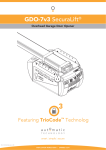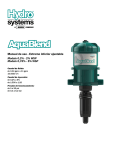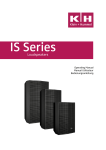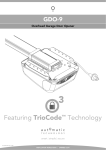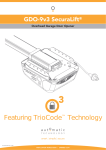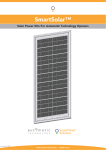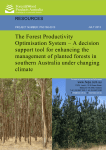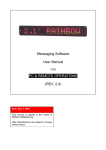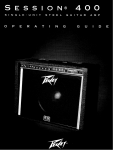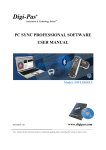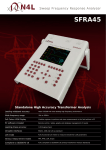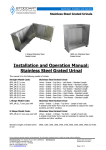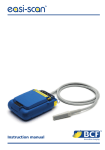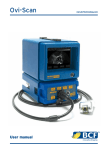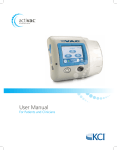Download AQUABLEND 1500 15MM THERMOSTATIC MIXING VALVE
Transcript
AQUABLEND 1500 15MM THERMOSTATIC MIXING VALVE For use in Australia Free Call 1800 671 864 Visit www.enware.com.au Part No. IS123 Enware Australia Pty Limited 9 Endeavour Rd Caringbah NSW 2229 Ph: +61 2 9525 9511 Fax: +61 2 9525 9536 Aquablend 1500 Thermostatic Mixing Valve Contents Introduction 3 Warranty 4 Safety 6 Product Range & Physical Description 6 Recommended pressures & temperatures 8 Flow sizing graph 9 Installation 10 Commissioning of the valve 12 Maintenance and servicing 15 Fault finding 16 Spare parts 18 Commissioning Report 19 Enware reserves the right to change any product specification or information contained in this publication, at any time and without notice. Every care has been taken to ensure accuracy in the Preparation of this publication which has been issued for guidance only. No liability can be accepted for any consequences which may arise as a result of its application. Enware = trade mark of Enware Australia Pty Limited - A.C.N. 003 988 314 Aquablend TMV’s are exclusively manufactured for Enware Australia Pty Limited by Reliance Worldwide, 27-28 Chapman Place, Eagle Farm, Qld, 4009 Australia. 2 Free Call 1800 671 864 Visit www.enware.com.au Aquablend 1500 Thermostatic Mixing Valve Introduction The ENWARE AQUABLEND 1500 Thermostatic Mixing Valve is a high performance Thermostatic Mixing Valve suitable for a wide range of applications. The valve is designed to comply with AS4032 - Thermostatic Mixing Valves. The mixing valve has the following features: • Complies with the requirements of AS4032 Thermostatic Mixing Valves, • Provides high stability of mixed water temperature even under changing inlet conditions, • Ensures rapid shut down of mixed outlet flow in the event of hot or cold water supply failure, • Designed for quick and simple in-situ servicing, • Suitable for installation into AS3500 compliant systems with hot water temperature as low as 55°C • Fitted with a Tamper Resistant temperature adjustment mechanism. Free Call 1800 671 864 Visit www.enware.com.au 3 Aquablend 1500 Thermostatic Mixing Valve Warranty The ENWARE AQUABLEND 1500 Thermostatic Mixing Valve is guaranteed free from manufacturing defects for a period of 24 months, subject to the conditions outlined below: Enware Product Warranty Subject to the warranty conditions and exclusions set out below ENWARE valves are warranted to be free from defects in material and/or workmanship for a period of 24 months service life and if found by ENWARE to be so defective will be replaced as set out below. If the valve is sold by a party other than ENWARE then it is sold by that seller as principal and the seller has no authority from ENWARE to give any additional warranty on behalf of ENWARE. The benefits of this warranty are in addition to all other rights and remedies which the purchaser may have under the Trade Practices Act (Cwth) or similar laws of each State and Territory in Australia. Warranty Conditions: 1. The valve must have been installed by a licensed plumber in accordance with the ENWARE Installation Instructions and Application Guidelines supplied with the valve, and in accordance with the National Plumbing and Drainage Code AS3500 (the Code) current at the date of installation and all relevant statutory and local requirements in the State or Territory in which the valve is installed. 2. Where the valve is installed outside the boundaries of a metropolitan area as defined by ENWARE, the cost of transport insurance and travelling shall be the purchaser’s responsibility. (Refer to the ENWARE scale of fees for replacement of valves). 3. Where the valve comprises part of a hot water system, installation of that system must be in accordance with its manufacturer’s recommendations, the Code and all relevant statutory and local State or Territory requirements. 4. The valve must be returned to ENWARE with a fully & correctly completed ENWARE Warranty Claim Form. 4 Free Call 1800 671 864 Visit www.enware.com.au Aquablend 1500 Thermostatic Mixing Valve 5. Where the valve is replaced under warranty the replacement valve carries a new warranty as detailed herein. Warranty Exclusions: Replacement work will be carried out as set out in the ENWARE Warranty above, but the following exclusions may cause the warranty to become void, and may incur a service charge including cost of parts where: 6. Damage has been caused by accident, Acts of God, misuse, incorrect installation of the hot water system of which the valve forms a part or attempts to disassemble the valve. 7. It is found that there is nothing wrong with the valve. 8. The failure of the valve is due in part or in whole to faulty manufacture/installation of the hot water system of which the valve forms part. 9. The valve has failed directly or indirectly as a result of excessive water pressure or temperature outside the Application Guidelines, thermal input or corrosive environment. 10.The valve has failed due to foreign matter either from installation or the water supply. 11.The failure of the valve is due to scale formation in the waterways of the valve. 12.The failure of the valve is due in part, or in whole, to installation not in conformance with the requirements of the Code. 13.ENWARE reserves the right to change its specifications without prior notice and will not accept liability for any claim arising from such change. 14.Subject to any statutory provisions to the contrary, claims for damage to furniture, carpets, walls, foundations or any other consequential loss either directly or indirectly due to leakage from the valve are also excluded from warranty cover. TM = Trademark of Enware Australia Pty Limited (ENWARE) 9 Endeavour Road, Caringbah NSW 2229 © All rights reserved 1996 Free Call 1800 671 864 Visit www.enware.com.au 5 Aquablend 1500 Thermostatic Mixing Valve Safety The ENWARE AQUABLEND 1500 Thermostatic Mixing Valve is a high performance valve designed to give stable and dependable operation, provided it is installed, commissioned, operated and maintained as per the recommendations outlined in this manual. It should be noted however that this valve should not be considered as an alternative to adequate supervision and duty of care during its use and operation. Note: When installed, the mixing valve, inlet controls, pipework and the surrounding area may become hot, which may cause burn injuries. Precautions should be taken to ensure that these surfaces cannot cause such injuries. Product Range & Physical Description The ENWARE AQUALBLEND 1500 Thermostatic Mixing Valve is available complete with inlet service fittings. The inlet to the fittings is ½” BSP male, and the outlet from the valve is ½” BSP male adapter with an optional ¾” BSP male adaptor. The service fittings consist of isolating ball valves, strainers, pressure test points and non-return valves. The strainers can be serviced and cleaned without disturbing the installation (refer to Section 10). The inlet service fittings also incorporate union type fittings enabling the thermostatic mixing valve to be removed from its installation without disturbing its pipework. The schematics and dimensions of the valve and corresponding order code are shown below in Figure 1.1 FIGURE 1.1 Physical Size AQUABLEND 1500 – AS CAST NICKEL PLATED FINISH With 1/2“ Male Thread Inlet and Outlet Fittings – Dry Weight 2kg ORDER CODE ATM 700 6 Free Call 1800 671 864 Visit www.enware.com.au Aquablend 1500 Thermostatic Mixing Valve Figure 1.2 shows a general arrangement drawing of the ENWARE AQUABLEND 1500 Thermostatic Mixing Valve showing the method of operation. Hot and cold water is supplied to each side of the valve respectively. The hot water enters through a port below the Piston, the cold water enters above the Piston. Upon entry the water begins to blend and enters the Mixing Tube. At this point the mixed water contacts the thermostatic wax Element. The Element will extend or contract to match the water temperature it is exposed to causing the Piston to move, thereby regulating the amounts of hot and cold water entering the valve. This thermostatic mechanism maintains the mixed water temperature at a constant temperature. If for example the inlet hot pressure dropped, the flow of hot water into the valve would be reduced and the valve would react as per the following sequence of events: • Element is exposed to mixed water at a reduced temperature • Thermostatic Element contracting • Piston is pushed upwards by the return spring restricting cold flow, consequently opening more of hot port. • Valve attempts to restore itself to original temperature setting. Similarly if the hot inlet temperature dropped, the element would again see blended water at a lower temperature and therefore the Element would again contract reducing the cold port piston gap and hence supply more hot water and less cold. Once again the valve attempts to restore itself to its original setting. This will occur for all changing conditions including changes to flow rate, inlet temperatures and inlet pressures. In the event of a sudden loss of the cold water supply the Piston will shut off the hot port thus stopping any flow through the valve. The valve will also shut down the cold supply if there is a hot water failure. Figure 1.2 General Arrangement Drawing Free Call 1800 671 864 Visit www.enware.com.au 7 Aquablend 1500 Thermostatic Mixing Valve Recommended Pressures & Temperatures MIXED OUTLET TEMPERATURE Temperature Adjustment Range 35°-48°Celsius INLET TEMPERATURES Cold Supply Hot Supply Minimum 5° Celsius Maximum 25° Celsius Minimum 55° Celsius Maximum 90° Celsius Hot to Mix Temperatures Differential for Stable Operation Minimum 10° Celsius Cold to Mix Temperatures Differential for Stable Operation Minimum 5° Celsius Minimum 4 litres/minute as per grpah 6.1 Minimum 20kPa Maximum 500kPa Maximum 1000kPa FLOW RATES To ensure stable outlet conditions DYNAMIC INLET PRESSURES Hot & Cold Inlet Pressures STATIC INLET PRESSURES Hot & Cold Inlet Pressures INLET PRESSURE RATIO Maximum inlet pressure ratio for stable operation. (Hot : Cold or Cold : Hot) 10:1 (either supply) NOTE: For optimum operation it is recommended that the hot & cold water supply pressures be balanced to within +/- 10%. NOTE: Notwithstanding the above, compliance with AS3500 must be maintained. 8 Free Call 1800 671 864 Visit www.enware.com.au Aquablend 1500 Thermostatic Mixing Valve Flow Sizing Graph The ENWARE AQUABLEND 1500 Thermostatic Mixing Valve is suitable for many applications. The Headloss Characteristic for Mixed Outlet Flowrate versus Balanced Inlet Pressure is shown below in Graph 2.1. It is important that the valve is not oversized for its intended application. Pressure Loss - kPa HEADLOSS CHARACTERISTICS OF AQUABLEND 1500 Flow - L/min Graph 2.1 - Headloss Characteristics Note: To ensure optimum performance the minimum outlet flow of the mixing valve during operation should be at least 4 litres/minute. It is important that the valve is sized such that the flow rates from the outlets are not less than those listed in AS3500.1.2. The pipework between the valve and the system must be sized in accordance with AS3500.1.2 – Appendix B to ensure the water velocity in the pipework is within the allowed limit. If the valve is to be installed and operated under unequal inlet pressures the lower inlet pressure determines the outlet flow rate. However, for optimum performance and stability it is recommended that the valve be installed with balanced dynamic inlet pressures (+/- 10%). Free Call 1800 671 864 Visit www.enware.com.au 9 Aquablend 1500 Thermostatic Mixing Valve Installation The ENWARE AQUABLEND 1500 Thermostatic Mixing Valve should be installed using the appropriate Standard, Code of Practice and legislation applicable to each state and following the details outlined in this section. The ENWARE AQUABLEND 1500 must be installed by a licensed plumber, or where applicable, a licensed plumber who has undertaken T.A.F.E. training in Thermostatic Mixing Valves. Note: To effectively control microbial hazards during system design, installation, commissioning and maintenance, the requirements outlined in AS/NZS3666 and local legislation shall be adhered to. Inlets and outlet connections of the valve are clearly marked. The letters H and C cast into the valve body indicates the Hot and Cold Inlet respectively. An arrow cast into the body of the valve identifies the valve outlet direction. If the valve is not installed correctly then it will not function correctly and may put the user in danger. It may also void the warranty of the valve. Prior to the installation of the valve, the system must be checked to ensure that the system operating conditions fall within the recommended operating range of the AQUABLEND 1500 Thermostatic Mixing Valve as detailed on page 9. If the hot water supply temperature is greater than 900C the valve may be damaged. A suitable temperature limiting valve must be fitted to the hot water supply, prior to the inlet fittings, if the temperature of the hot water will rise above 90°C. This temperature limiting valve must be installed as per the manufacturer’s instructions. It is also important that both of the inlet dynamic supply pressures are 500kPa or less. If either supply pressure exceeds 500kPa then a suitable pressure reducing valve must be fitted prior to the inlet control valve to reduce the pressure to an acceptable limit. These pressure reducing valves must be installed as per the manufacturer’s instructions. In order to achieve optimum performance from the valve it is recommended that the inlet pressures are balanced to within 10% of each other. The water quality conditions should be checked to ensure they do not exceed the limits as listed in AS3500.4, Section1.6 If they do exceed these limits then it will be necessary to install a water softener or water treatment device. 10 Free Call 1800 671 864 Visit www.enware.com.au Aquablend 1500 Thermostatic Mixing Valve NOTE: In some installations certain types of faucet devices such as flick mixers and solenoid valves are used. The water pressure may be seen to spike outside that recommended, for the valve, during rapid shut off conditions with these types of devices. Even if the spike only lasts a split second it is still considered to be outside the operating conditions and may cause the valve to operate incorrectly. In the event that this does occur measures must be taken to control the spike, such as an inline pressure reducing valves directly before the valve inlets. To ensure that the mixing valve operates correctly it is necessary that the pipework is thoroughly flushed with clean water before the valve is installed. This will remove any physical contaminants from the pipework, ensuring trouble-free operation. During the flushing procedure care should be taken to prevent water damage occurring to the surrounding area. It is required by AS3500.4.2 that “Each thermostatic mixing valve shall have an isolating stop tap/valve, line strainer and non-return valve fitted to the hot and cold water supply lines”. The inlet fittings supplied with each TMV will ensure this requirement is met. If the ENWARE AQUABLEND 1500 Thermostatic Mixing Valve is to be installed without the supplied inlet control valves then it will be necessary to install a separate isolating valve, non-return valve and strainer to both inlets to the valve. Strainers must be fitted to prevent any particulate contamination from entering the valve. These strainers should be 60 Mesh stainless steel. Isolating valves are required so that the water supply to the valve can be isolated in the event that servicing is required. Non-return devices must also be fitted to both the hot and cold inlets to prevent cross-connection. Ensure that the test plugs in the top of the inlet fittings are tight. The valve should be installed so it can be accessed easily for maintenance or servicing. The valve can be installed in a wall cavity, under a basin or on a wall, however it is essential that the mixing valve and inlet fittings are easily accessible for servicing. During installation or servicing heat must not be applied near the mixing valve or inlet fittings, as this will damage the valve and inlet fitting internals. Failure to comply with this requirement will damage the valve and fittings. It will put the user at risk, and it will void the warranty of the valve. Free Call 1800 671 864 Visit www.enware.com.au 11 Aquablend 1500 Thermostatic Mixing Valve Figure 2.1 Schematic Installation Diagram Commissioning Of The Valve Upon completion of the installation, the valve should be tested & commissioned as per the procedure outlined below or as specified by the local authority. The entire procedure should be read through thoroughly prior to the commissioning of the valve. A calibrated digital thermometer having rapid response time with maximum temperature hold, small flat bladed screwdriver and the adjusting key (supplied with the AQUABLEND 1500) will be required to check & set the outlet mixed temperature of the valve. 12 Free Call 1800 671 864 Visit www.enware.com.au Aquablend 1500 Thermostatic Mixing Valve • Ensure all outlets that will be serviced by the valve have adequate warning signs posted to ensure that no outlet is used during commissioning. • Open the cold supply line to the valve, then open the hot supply line, ensuring there are no leaks. • Open the outlet that is serviced by the shortest length of pipe work between the mixing valve and outlet fixture. • Allow the mixed outlet to flow for at least 60 seconds to allow the temperature to stabilise before taking a temperature reading at the outlet with a digital thermometer. The flow rate should be at least 4L/min. The flow rate can be checked with the aid of a known size container and a stopwatch. The temperature should be taken at the closest outlet served by the thermostatic mixing valve. • If the outlet temperature requires adjustment the followings steps are required; Temperature Adjustment 1. Using a small flat bladed screw driver lever the protective cover off the valve (figure 2.1). 2. Fit the supplied key over the adjusting spindle (figure 2.2) • To increase the mixed outlet temperature, rotate the spindle anti-clockwise. • To decrease the mixed outlet temperature, rotate the spindle clockwise. 3. Allow the mixed outlet temperature to stabilize for 60 seconds and once again take a temperature reading. Repeat the procedure until the desired temperature has been reached. 4. Push the top cover firmly on to the top of the valve until it ‘snaps’ back into place. 5. Check that the outlet temperature is stable over the full range of flow rates and that the flow rate is adequate for the application. 6. Close the outlet. 7. The mixing valve is now set and locked. Free Call 1800 671 864 Visit www.enware.com.au 13 Aquablend 1500 Thermostatic Mixing Valve Figure 2.2 Increasing and Decreasing the Mixed Water Temperature Shut Down Test • Now that the mixing valve has been set and locked it is necessary to perform a shut down check. Allow the mixed water temperature to stabilise and note the outlet temperature. While holding a digital thermometer in the outlet flow, quickly isolate the cold water supply to the valve. The outlet flow should quickly cease flowing. As a rule of thumb the flow should be less than 0.1L/min following the isolation. Monitor the maximum outlet flow temperature, and record this on the Commissioning Report (Appendix A). The temperature should not exceed that allowed by the applicable standard or code of practice for each state. Restore the cold water supply to the valve. After the mixed water temperature has stabilised note the outlet temperature ensuring the outlet temperature has re established. • Repeat the above test, except this time quickly isolate the hot water supply to the valve. The outlet flow should quickly slow to a trickle. As a rule of thumb the trickle should typically be less than 0.4L/min@500kPa down to less than 0.1L/min@100kPa following the isolation. Restore the hot water supply to the valve and measure and record the outlet temperature after the mixed water temperature has stabilised ensuring the outlet temperature has re established. • Ensure that all details of the Commissioning Report are completed & signed by the relevant signatories & a copy is kept with the installer and owner of the premises. • The valve is now commissioned and it can be used within the technical limits of operation. 14 Free Call 1800 671 864 Visit www.enware.com.au Aquablend 1500 Thermostatic Mixing Valve Maintenance And Servicing The ENWARE AQUABLEND 1500 Thermostatic Mixing Valve will only require minimal preventative maintenance work to ensure it operates at its optimum level of performance. The valve should be commissioned and serviced annually, unless the installed conditions dictate more frequent servicing is necessary. Annual Maintenance Procedure Every 12 months the ENWARE AQUABLEND 1500 should be inspected & tested. The valve should be given a light wipedown of the external surface. The valve & surrounding area should be inspected for leaks or water damage and appropriate action taken if required. Ensure a clean dry work area is available. Firstly isolate the hot and cold supplies to the mixing valve by closing the inlet ball valves. Remove the inlet fitting top cover with a suitable spanner and then remove the mesh strainer, as shown in Figure 3.1 below. The strainers should be cleaned with a dilute water solution of suitable descaling solvent (such as CLR), checked for physical damage and then thoroughly rinsed with clean water. The strainers can then be re-installed into the valve, and the top cover replaced and tightened to a maximum torque of 15Nm into the inlet valve bodies. If the valve fails to shut down or fails to maintain its set temperature then refer to the fault finding solutions outlined on page 15. The valve piston ‘O’ ring and thermostatic element / piston assembly must be replaced at intervals not exceeding 5 years. Check that the test plugs in the top of the inlet fittings are tight and that there is no evidence of water leakage. The valve must then be recommissioned as per page 11, including temperature adjustment and the shut down test. Figure 3.1 Removing the Inlet Strainer Free Call 1800 671 864 Visit www.enware.com.au 15 Aquablend 1500 Thermostatic Mixing Valve Fault Finding FAULT / SYMPTOM CAUSE RECTIFICATION The desired mixed water temperature cannot be obtained or valve is difficult to set. • Hot and cold supplies are fitted to the wrong connections. • Valve contains debris. • Strainers contain debris. • Non-return devices are damaged • Top Cap and/or Piston O-rings are damaged • Refit the valve with Hot/ Cold supplies fitted to the correct connections. • Clean the valve ensuring that all debris is removed and components are not damaged. • Clean strainers ensuring debris is removed. • Check non-return device is not jammed.Clean it if necessary. • Check Top Cap & Piston O-rings for damage. Replace if necessary. The valve will not shut down • The hot to mix temperature differential is not 10°C or greater. • The piston O-ring is damaged. • Rubber sealing seat is damaged or fouled by debris. • Thermostatic element has failed. • Raise hot water temperature. • Replace piston O-ring. (ATMS1215) • Clean seat using mild descaling solution. • Replace element. (ATMS1206). Mix temperature unstable • Debris is fouling valve. • Flow rate below 4L/min. • Strainers are fouled. • Clean the valve ensuring that all debris is removed and components are not damaged. • Rectify any pressure deterioration. • Clean strainers. Mix temperature changing over time • Inlet conditions (pressures or temperatures) are fluctuating. • Strainers contain debris • Install suitable pressure control valves to ensure inlet conditions are within those stated on page 7. • Clean strainers ensuring debris is removed 16 Free Call 1800 671 864 Visit www.enware.com.au Aquablend 1500 Thermostatic Mixing Valve FAULT / SYMPTOM CAUSE RECTIFICATION Either full hot or cold flowing from outlet fixture • Valve is incorrectly set. • Hot/Cold water has migrated to other inlet. • Refer also to fault/ sympton 1 & 2 • Adjust mix temperature between 35 - 50°C as required. • Replace faulty nonreturn valves (ATMS1212). No flow from the valve outlet • Hot or cold water failure. • Strainers are fouled • Valve functioning correctly. Restore inlet supplies and check mix temperature. • Clean strainers. Flow rate reduced or fluctuating • Valve or inlet fittings fouled by debris. • Dynamic inlet pressures are not within recommended limits. • Check valve and inlet fittings for blockages. • Ensure operating conditions are within specified limits and the dynamic inlet pressures are nominally balanced to within +/- 10%. Mixed water temperature too hot or cold • Valve has been tampered with. • Valve incorrectly set. • Inlet temperatures are not within specified limits. • Readjust valve to required set temperature. • Readjust valve to required set temperature. • Ensure inlet temperatures are within the specified limits as listed on page 7. Mixed water temperature doesn’t change when the temperature adjuster is altered • Return spring is missing • Thermostatic element has failed • Install return spring (ATMS1211). • Replace thermostatic element (ATMS1206). Mixed water temperature adjuster difficult to move • Adjuster at maximum mix temperature stop. • Valve piston into overstroke • Mixed water is at maximum temperature. No higher mix temperature adjustment is available. • Wind adjuster out until set temperature required is achieved. Free Call 1800 671 864 Visit www.enware.com.au 17 Aquablend 1500 Thermostatic Mixing Valve FAULT / SYMPTOM CAUSE RECTIFICATION Hot water flows into the cold water system or vice versa. Non-return valves. Replace non-return valves (ATMS1212). Valve is noisy. Water velocity above velocity requirements of AS3500.1.2 Reduce water velocity. Spare Parts PART REPLACEMENT TIME PART NUMBER Fitting Assembly As required ATMS4542 Inlet Fitting Service Pack As required ATMS1313 Thermostatic Element/Piston Assembly 5 yearly ATMS4715 O-Ring Kit 5 yearly ATMS4714 18 Free Call 1800 671 864 Visit www.enware.com.au Aquablend 1500 Thermostatic Mixing Valve Enware Thermostatic Mixing Valve Commissioning Report For Thermostatic Mixing Valves use a separate sheet for each valve Establishment Address Phone No Contact Date Work Order No. Make & Model of Hot Water Unit Pressure kPa Hot Water kPa Pressure Cold Water Temp ˚C Pressure Reducing Valve Fitted Cold Water Supply via ˚C Temp YES/NO Model No Make of Mixing Valve Size Valve Location / Building Total No. of Mixing Valves on Site/ Building Valve ID No. Total No. of outlets served by this valve Baths Basins Showers Other outlet details Valve installed to requirements of The drawing & specification The valve manufacture /supplier The code of TMV’s The local water supply authority YES/NO YES/NO YES/NO YES/NO If NO, give details and action taken Free Call 1800 671 864 Visit www.enware.com.au 19 Aquablend 1500 Thermostatic Mixing Valve Test results (complete table on following page) Valve considered satisfactory for use YES/NO If NO, state reason and action taken It is hereby certified that all the commissioning work has been carried out by the undersigned in accordance with local plumbing requirements for Thermostatic Mixing Valves Date initial service due: (Maximum 12 months use) Valve commissioned by: Lic/Cert No Signature Licensed Plumber Business name of Plumbing Contractor Date Contractors Authority No NOTE: A duplicate copy of this report is to be retained at the site for any inspection by authorised persons. The following information is to be provided by site manager/owner: Valve size and installation recommended by (name) Valve supplied by (name) Valve installed by (name) Date of installation: Drawing No: Certificate of Compliance/Inspection No: Service manual on site: Dated: YES/NO Report received by (name) Position Signature Date: For and on behalf of the client/site manager/owner 20 Free Call 1800 671 864 Visit www.enware.com.au Aquablend 1500 Thermostatic Mixing Valve Test results Valve location/building Room or area designation Work Order No Warm water outlet fixture No. Name/type/ size & location of outlet fixture (bath, shower, basin or other) Flow rate of design warm water (L/sec) Temp of warm water °C 1 outlet in use 1 outlet in use ** All req. outlets in use ** All req. outlets in use 1. 2. 3. 4. 5. 6. 7. 8. Give details of brand and model designation. Commensurate with the design flow rate for the mixing valve. NOTE: An accurate digital type thermometer is necessary for the temperature measurements. Prescribed temperature range for warm water Fail safe at both minimum and maximum design flow rates °C to °C PASSED/FAILED Signature of licensed plumber Licence/Cert No Business name of plumbing contractor Contractor’s authority No: Free Call 1800 671 864 Date: Visit www.enware.com.au 21 Aquablend 1500 Thermostatic Mixing Valve Enware Thermostatic Mixing Valve Servicing Report For Thermostatic Mixing Valves use a separate sheet for each valve Establishment Address Phone No Contact Date Work Order No. Make & Model of Hot Water Unit Model No: Mixing Valve Make: Size Valve Location / Building Total No. of Mixing Valves on Site/ Building Valve ID No. Total No. of outlets served by this valve Baths Basins Showers Other outlet details Valve installed to requirements of: The drawing & specification The code of TMV’s The code of TMV’s The local water supply authority YES/NO YES/NO YES/NO YES/NO If NO, give details and action taken Any current complaints concerning installation or operation reported or stated in previous report If YES, give details: YES/NO Particulars of service work carried our during this visit List of items replaced (and part numbers) during this visit: Warm water temp. at outlet °C Fail Safe Test PASSED / FAILED Valve considered satisfactory for further use YES/NO If NO, reason and action taken: Date next service due (12 months maximum): 22 Free Call 1800 671 864 Visit www.enware.com.au Aquablend 1500 Thermostatic Mixing Valve It is hereby certified that all the commissioning work has been carried out by the undersigned in accordance with local plumbing requirements for Thermostatic Mixing Valves Lic/Cert No Signature Licensed Plumber Business name of Plumbing Contractor Date Contractors Authority No NOTE: A duplicate copy of this report is to be retained at the site for any inspection by authorised persons. The following information is to be provided by site manager/owner: Valve size and installation recommended by (name) Valve supplied by (name) Valve installed by (name) Date of installation: Drawing No: Certificate of Compliance/Inspection No: Service manual on site: Dated: YES/NO Report received by (name) Position Signature Date: For and on behalf of the client/site manager/owner Free Call 1800 671 864 Visit www.enware.com.au 23 Free Call 1800 671 864 Visit www.enware.com.au Enware Australia Pty Limited 9 Endeavour Rd Caringbah NSW 2229 Ph: +61 2 9525 9511 Fax: +61 2 9525 9536

























